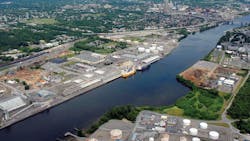Report stresses need for investment in US offshore wind port development
Offshore staff
The report is authored by Brian Sabina, CEO of Clean Energy Terminals, in partnership with the BNOW's member-driven Ports Working Group.
The report is a $36 billion plan for developing domestic port infrastructure to help the US reach its offshore wind deployment goals of 30 GW by 2030 and 110 GW by 2050. It offers practical cost and timing requirements for needed projects to ensure ports are ready to meet current and future demand. The paper also outlines approaches state and federal policymakers could take to encourage private investment, either by subsidizing portions of the infrastructure costs or by de-risking projects to drive confidence and cost-efficiency.
The report’s key findings include:
- Port infrastructure is one of the most significant bottlenecks impeding the advancement of the US offshore wind industry.
- The US needs about 99 to 119 port development sites across the East Coast, West Coast and the Gulf of Mexico to support the full buildout of the industry. To date, 35 are already operating or under development.
- Without additional government funding and policy supports that incentivize or de-risk private investment into US offshore wind port infrastructure, port capacity will continue to be a major offshore wind deployment constraint across the country.
- The total cost to address the nation’s offshore wind port infrastructure gap is estimated to be $36 billion over the next decade when accounting for construction cost inflation.
- The needs of specialized ports on the West Coast to support floating offshore wind development comprise more than a third of the overall US market need.
“The offshore wind industry has gained enormous momentum in just the last year, with steel in the water on the first two US commercial-scale projects,” said Liz Burdock, president and CEO of the Business Network for Offshore Wind. “However, the shortage of port infrastructure developments is a critical bottleneck to industry growth that risks derailing progress. Federal and state governments must work together with private industry to incentivize and finance new offshore wind port projects to support our growing industry and create thousands of jobs in the process.”
While development of the US offshore wind industry has accelerated rapidly in the past two years, the industry’s long-term ability to scale and meet demand faces key bottlenecks and hurdles. That includes the US port infrastructure system that is currently unable to support projected offshore wind component manufacturing and project deployment. BNOW said more than $2.5 billion has already been invested in US ports, but unleashing the full potential of the industry requires a new understanding of long-term port needs and development timelines to enable sustainable offshore wind growth that will create thousands of manufacturing, logistics and operations jobs.
"The offshore wind industry is poised to invest hundreds of billions of dollars into clean energy generation and manufacturing over the next 25 years,” Sabina said. “To unlock this long-term opportunity, we need to build more port infrastructure right now. Ports turn offshore wind project spending into family-sustaining careers for American workers and growth opportunities for domestic businesses. These facilities are major infrastructure projects that take years to develop and build. Without decisive action today, the country is at risk of falling short of our offshore wind deployment goals and losing out on this once-in-a-generation jobs and investment opportunity."
09.25.2023





